|
|

|
Front page or cover of the German fashion magazine Modenschau (Eng. title: Fashion Show; subtitle: Illustrated monthly magazine for home and society) no. 170 for February 1927.
J 2859. Spring coat of brick red cloth in new cut for girls aged 6 to 8 years. Fabric usage: 1.90 m 130 cm wide. (Small pattern.)
J 2860. Coat dress in dark blue and cream-colored rep papillon with pretty embroidery decoration. Fabric usage: 3.10 m darker, 0.85 m lighter, each 130 cm wide. Transfer pattern 80 pf. (for subscribers.) Pattern size 44 and 48. (Large pattern.)
J 2861. Transitional dress in banana-colored crepe romain, combined with raspberry red. Matching light embroidery border. The belt has a black galalith buckle running through it. Fabric usage: 2.80 m lighter, 1.25 m darker, each 100 cm wide. Price 1.60 Mk. (for subscribers). Pattern size 44 and 48. (Large pattern.)
Price per copy: 60 pf., with pattern sheet 70 pf., plus local delivery charge.
[Stamp:] Trial number.
Publishing company Gustav Lyon, Berlin SO 16 — Delivery for the book trade in Germany Wilhelm Opetz, Leipzig.
Title illustration/title drawing: unknown/unsigned.
|
|
|
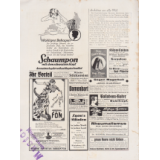
|
Article:
N. N., Anecdotes from Around the World.
Advertising:
Pleasant comfort… The magnificent foam, the refreshing fragrance, the delicious feeling of cleanliness: a real pleasure is the head wash with Schwarzkopf shampoo. Get to know the pleasure! Shampoo with the black head. Most sought after - because the longest proven. Drawing/illustration: unknown/unsigned.
[Self-promotion of the publishing house Gustav Lyon, Berlin SO 16] It is to your advantage to turn primarily to the advertisers of the "Modenschau" for inquiries and purchases.
Hair dryer… Youth, health, beauty, lust for life… Fortuna. She has put down the horn of plenty, instead of it she carries a "hair dryer;" She wants to give you youthfulness and beauty with always full hands. Only genuine with embossed trademark "FOEN." Hundreds of thousands in use! For body and beauty care "Sanax-Vibrator," "Penetrator," 'Vibrofix' and 'Sanofix' electric massagers, "Radiolux" and "Radiostat" D. R. P. (German Reich patent) ground-fault-free, electric high-frequency devices. Safety heating pad Sanotherm with vacu-regulator D. R. P. Available everywhere! For every funny advertising idea sent to us, we will donate an original hair dryer to the sender. FACTORY "SANITAS" BERLIN N24.
Lingerie embroidery and bobbin lace, distinctive patterns. Quality goods -;- Lowest prices! -;- Patterns free of charge! Embroidery mail order house 'Germania', Berlin M., SO 16, Schmidstr. 41.
Ladies beard. A painless, simple radical remedy communicates free of charge: Mrs. J. Blocherer, Augsburg 2/65, Reisingerstrasse 9.
20 meters of women's fabric or 10 meters of men's fabric will be made for anyone who sends 5 kg of old wool to Wollweberei (Wool Mill) Carl Schuetz, Lardenbach 11 (Upper Hesse). Ask for samples and prices free.
[Self-promotion of the publishing house Gustav Lyon, Berlin SO 16] Lyon's branches are in every city in every country — Newly opened: Spandau, Bahnhofstrasse 1 corner Stresowplatz. Gdansk, Jopengasse 61. Koenigsberg i. P., Muenzstrasse 4.
Peru tannin water for hair care. Trademark: The Daughters of the Inventor.
Bobbin lace. 1 pound at 5.— Mk., shipped postage paid against cash on delivery. Brinkmanns Spitzenversand [Lace Mail Order] Langerfeld-Barmen.
Corpulence. Shortest most successful special treatment of the present for permanent comfortable elimination. Free information through "Eclu" Cologne 91, P.O. Box 148.
For coats: dazzlingly beautiful fur plush. Precious silk seal plushes, Persian lamb, Astrakhan, foal, etc. Modern lining silks. Patterns, which? 8 days to choose from. Samthaus [Velvet House] Schmidt. Hanover 16P.
Against leanness, always use only our "Oriental Power Pills". In a short time, they cause considerable weight gain, a blooming appearance and a beautiful, full body shape (for ladies a splendid bust); they strengthen the desire to work, blood and nerves. Guaranteed harmless. Recommended by doctors. Many letters of thanks. World famous for 28 years. Prize awarded with gold medal and diploma of honor. Price pack (100 pieces) 2.75 M. with instructions. Postage extra. (Postal order or cash on delivery.) D. Franz Steiner & Co. G.m.b.H., Berlin W30/469, Eisennacherstr. 16.
Pallabona powder cleans and degreases hair by dry means, makes beautiful hairstyle, especially suitable for bob. Indispensable for dancing and sports. Available in doses from M. 1.— and up in barber shops, perfumeries, drugstores and pharmacies. Refuse all imitations!
Annoying hair on the face and body removes immediately and radical only my "Hewalin Hair Remover" (protective brand). Often imitated — but never achieved! German Imperial Patent No. 196 617. Gold medal: Paris, Antwerp. By physicians, dermatologists and court-certified chemists as completely harmless and safe working excellently reviewed. Price M. 5.—. Sole manufacturer: H. Wagner, Cologne 133, Blumenthalstr. 99.
Rheumatism, gout, sciatica, nervous disorders! Why do you toil for weeks and months? Dr. Tetzner's Rheumatism and Nerve Salt is absolutely proven. It increases the elasticity of the nerves and gives a youthful and fresh appearance. In jars of Mk. 3.— long lasting, free cash on delivery. Dr. TETZNER, Altona-Othmarschen 33.
For those who do not want to dye gray hair: Entrupal Haarstaerkungswasser [Hair Strengthening Tonic], protected by law, supplies the weakened hair roots with the used pigments (dyes), so that gray hair and offspring naturally regain their former color, therefore off-color is excluded. Easy to use. Guaranteed harmless. Original bottle Mk. 4.50. Brochures free of charge. Available at Simons Pharmacy, Berlin C. 101, Spandauerstr. 17.
[Stamp at bottom left:] Sample. Not for sale!
|
|
P. 1 |
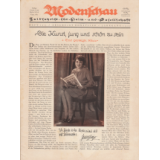
|
Title page or cover of the Modenschau (Eng. title: Fashion Show; subtitle: Illustrated monthly magazine for home and society) no. 170 for February 1927.
Article:
Parsen, P., The Art of Being Young and Beautiful. 2. The Well-Groomed Hair (by P. Parsen, unknown author).
In the center of the page is a large photographic image of the Austrian silent film actress Jenny Jugo (née Eugenie Anna Walter, 1904-2001). She is sitting on a chair holding an open edition of the August 1926 Modenschau in her hands and looking smilingly into the photo camera. The caption reads "I always find a lot of interesting things in the Modenschau. Jenny Jugo."
Photo: unknown/unsigned.
[Parsen, P., The Art of Being Young and Beautiful. 2. The Well-Groomed Hair].
The hair on your head is like the purple of the king! The poet of the Old Testament Song of Solomon finds nothing more delicious for comparison than the proud ornaments of princes to praise the glorious locks of the beloved. And with it, through the love songs of all times and poets, through fairy tales and legends, the eternal song of the beauty of a woman's hair resounds. People and times change, concepts of beauty change, but unchanged for thousands of years we see in the crown that Mother Nature gave to woman, the crowning glory of her beauty. Women's hair becomes for us a symbol of their nature: the blonde is considered to be gentle and tender, the brunette has the reputation of being more lively! (That here, of course, the law of the confirmation of the rule by the exceptions applies all the more needs hardly to be mentioned!) And at all times women have endeavored to cultivate the delicious ornaments which nature bestowed upon them in more or less abundant measure, and through this cultivation to make them ever richer and more charming. The fact that they took many a wrong turn — one only has to think of the bizarre headdresses of the ladies of the Rococo period, who wore entire scenes and symbolic representations on their heads, the production of which required hours of laborious work — ultimately only proves the great value they attached to the adornment of their heads. Everything that serves women as jewelry is subject to the eternal change of fashion! Fashion is something feminine and lives from the striving for change. The woman is always filled from her innermost being by the desire to transform the given for her personality. And the all-good nature smilingly puts up with all the oddities by which times and fashions want to "embellish" her gift; for she is, after all, stronger than the arbitrary bizarreness of human whims. Inexhaustibly she gives the gifts of beauty from the rich cornucopia and demands only one thing: that these gifts be cared for and preserved. To the one who obeys this simple commandment, it rewards with a double wealth of beauty. — If one day our time will be given a special name in the cultural history of mankind, then it will have to be called the age of hygiene. We have recognized that only healthy things can be truly beautiful. From this realization, tireless scholars are researching the laws of nature, the origin of growing and becoming, unveiling ever new secrets and finding ever new "paths to strength and beauty," these glorious goals of mankind. And their industrious work, their ingenious discoveries become more and more common knowledge and teach us to live in such a way that we make of ourselves what nature gave us her gifts for: healthy, vigorous, well-groomed human beings! "The more the demands of our existence seek to destroy nerves and forces, the more eagerly we must care for our bodies!" is the law of the times. And our body is such a wonderfully finely organized mechanism that every part requires special care; nothing must be neglected if the whole is to be capable of maximum performance! Our hair is not there just for the sake of beauty; it covers the most important part of our being: the brain. So, quite logically, any neglect in its care must have harmful repercussions on the center of our body mechanism! Proper hair care is not only for the beautification of our outer man, but it is a hygienic necessity. It really does not require too much work, [continued on p. 2.]
[Page] 1
|
|
P. 2 |

|
Article:
Parsen, P., The Art of Being Young and Beautiful. 2. The Well-Groomed Hair (by P. Parsen, unknown author).
Matching the article is a large photographic image of Russian actress Elisabeth Pinajeff (née Yelisaveta Sergeyevna Pinaeva, 1900-1995). The caption reads "The famous film actress Elisabeth Pinajeff with fuzzy head."
Foto: Alexander Binder, Berlin (1888-1929).
[Parsen, P., The Art of Being Young and Beautiful. 2. The Well-Groomed Hair].
[Continued from p. 1] if only it is done regularly. As everywhere in hygiene, of course, health of the blood is supreme. Human hair is formed as a result of certain substances in our body, hormones, which give rise to a horn-like substance, the hair shaft. These building substances are sufficiently formed in the blood of a healthy person to be able to develop strong hair. Every disturbance of the blood composition, of the general body functions in general, which can often arise from purely mental reasons, therefore already threatens the growth of our hair under certain circumstances. We know that many diseases, e.g. scarlet fever, influenza, typhoid fever, often cause severe hair loss, which only stops when the patient recovers. Therefore, if you want to have beautiful, i.e. healthy hair, you must live a healthy life: Food, work and rest must be regulated according to the laws that are, after all, common knowledge today. Irregularities of the way of life and mental excitations must be avoided as far as possible.
But nature does not only demand from us that we support her building work by a reasonable way of life; we must always strive to preserve what has been created. And here above all the law of hygiene applies, that healthy life is impossible without cleanliness. But the greatest enemy of all hygiene is dust! We can only protect ourselves from it if we vigorously get to grips with it, which naturally prefers to settle in dense hair. Therefore, daily combing and brushing should not be considered as a means of creating a more or less artistic hairstyle, but is first and foremost a mechanical removal of dust. But for this we need the right comb and the brush. The comb must not be too narrow, because otherwise it will tear the hair mercilessly and take away many a healthy hair, it must not be too sharp at its tips, because otherwise the sensitive scalp could easily be injured. Combing does not mean cleaning the hair, but it should only prepare the hair for the work of the brush by correct storage — namely according to the direction of its growth. This brushing work, which is indispensable in the morning and in the evening, should first of all mechanically remove all dirt and dust that lies loosely on the hair and the hair base. Therefore, the brush must be constructed in such a way that it can really reach through the hair to the scalp, i.e. it must not have bristles that are too short, but on the other hand it must not be too hard either, in order to avoid injuries to the scalp. Today, the modern cosmetic industry offers such a wide range of different shapes that every woman can find her individual brush. Correctly and expediently brush the hair first in the direction in which it has grown, then against the grain. Energetic shaking of the head after brushing twice loosens the hair especially well and should therefore be the conclusion of each brushing of the hair. — However, this mechanical cleaning of the hair and the hair floor is by no means sufficient. Because our hair is nothing dead, but a living part of our body. At the end of the hair shaft sit the so-called sebaceous glands, which constantly secrete a fat that serves to nourish the hair and at the same time makes it supple. These fat secretions are now naturally deposited on the scalp and, together with the dust, form a mass that cannot be removed by brushing alone. Therefore, the mechanical cleaning of the hair must be supplemented by chemical action, or more understandably, by washing the scalp. Whether this is done by the expert hands of a hairdresser or at home in the privacy of one's own home is a question of time and money, but the process is basically always the same: the dissolving action of warm water and chemical agents is used to remove the grease and the dirt associated with it. The most primitive means is, of course, the ordinary soap, which is finely scraped and boiled in water with a little borax soap. However, since it is often too sharp and thus harms the skin, one likes to use the milder effect of a boiling of 2 tablespoons of quillaya bark in a liter of water, which — strained — makes an effective head wash; if one does not prefer to use one of the head wash soaps in liquid form available everywhere today or another commercial preparation. In the production of finished shampoos, not only the cleansing effect is taken into account, but also ingredients that are valuable for the nourishment of the hair are usually incorporated. Thus, by using them, one achieves not only cleaning, but also strengthening of the hair base. The tar recommended by Prof. Lassar, the famous physiologist from Wroclaw, in its strengthening effect is nowadays contained in most hair washing soaps and has an excellent effect. The cleansing and strengthening effect of egg yolk for washing the head, and of chamomile boils that preserve the color of blondes, is already known almost everywhere, but should also be mentioned for the sake of completeness. However, no matter which means one chooses for washing one's hair, one should always pour a shot of diluted good vinegar over the hair after rinsing it, rub it quickly through the hair and then rinse it off again immediately. This makes the hair particularly supple and gives it a soft shine. With what and where the procedure of hair washing is carried out, however, it must always be ensured that the hair is dried thoroughly and quickly afterwards: it is only too easy for a cold draught to hit the sensitive scalp, which after washing lacks the protective grease coating, and lead to very painful colds of the nerves; many an agonizing neuralgia has already arisen in this way! The modern electrical engineering in its hot air showers always offers the possibility to shorten the drying process of the hair. How often healthy hair should be washed at all cannot be decided schematically, of course. In general, the procedure should be done every 8—10 days. However, if your hair is particularly strong and perhaps secretes more grease, it is better to wash it every week, while a lady with very dry hair should wash her head only every 14 days, so as not to extract too much grease from it. This will also do well to [continued on p. 3.]
[Page] 2
|
|
P. 3 |
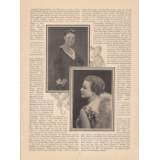
|
Article:
Parsen, P., The Art of Being Young and Beautiful. 2. The Well-Groomed Hair (by P. Parsen, unknown author).
Matching the article are two photographic images of actress Lotte Ander (biographical data unknown) and an unknown woman. The captions read "Actress Lotte Ander wears the Eton crop" and "The Eton crop currently favored in America with large waves."
Photo: unknown/unsigned.
[Parsen, P., The Art of Being Young and Beautiful. 2. The Well-Groomed Hair].
[Continued from p. 2] support the lack of self-production of the scalp of fat by vigorously rubbing a drop of pure olive oil into the scalp with the fingertips after each wash. This has a double effect: the dry scalp is lightly greased and the blood vessels are stimulated to increased activity by the massage. Massage is known to be best for the whole skin of our body. Therefore, it is recommended to all ladies who want to take proper care of their hair. It is a good way to finish the morning and evening combing: thumb, index and middle fingers of both hands energetically reach to the bottom of the hair and rub it everywhere in a circular motion. More comfortable, of course, is the massage by modern whalebone brushes, as they are the latest in the cosmetic industry: the elastic strength of the whalebone bristles ensures the penetration of the hair to its base, without fear of injury to it. Whether one wants to support the blood circulation in the skin promoting effect of the scalp massage still by the stimulating effect of alcohol-containing head waters, is to be decided again only individually. It is certain that alcoholic rubs have a fat-dissolving effect and promote blood circulation; however, it must be remembered that the constant removal of fat can easily cause the hair to become brittle and break. Therefore, in this case, depending on the type of hair, choose a head lotion that contains a more or less strong addition of fat.
The cause of so many disturbances of the hair growth and the beauty of the hair lies in the fat supply at all. Our skin is in a state of constant regeneration, it scales off. In the case of normal hair, these shed skin particles are removed by the prescribed care. However, if the skin is too dry — that is, if it is not sufficiently nourished with fat — an overproduction occurs, which we then call scurf or dandruff. Therefore, as soon as the first signs of these disturbing phenomena appear, they must be combated by frequent washing with lukewarm water, to which 5 parts of carbonic acid sodium bicarbonate per 100 parts have been added, and an adequate supply of fat must be provided from the outside. The same applies to the treatment of the hair, which is dull and dry due to lack of supply of fat from the sebaceous glands. Only it is recommended to supply the fat to the hair in the form of oil of rinzinus, of which we mix 15 gr. with the same quantum of tincture of benzoin, spirit of soap and ten times the quantity of alcohol. If you love fragrance, you can add some lavender or rose oil to this mixture as a perfuming agent. If this mixture is brushed into the hair and onto the scalp, it will soon regain its shine and softness. However, if the scalp receives too much grease, i.e. if the hair is particularly greasy, the problem must first be tackled from the inside, literally at the root (of the hair), by abstaining from greasy food. At the same time, in addition to weekly washing with soapy water with added borax or tar soap, the problem must be tackled from the outside with a thorough head massage, because the properly circulating blood washes away all superfluous grease. To get rid of the unattractive appearance of greasy hair as quickly as possible, it is rubbed every morning with a cotton ball dipped in ether, which removes the grease superficially without affecting the marcel waves. If, however, the hair suddenly starts to go out without any noticeable external cause, such as illness, nervous strain, heavy worries, even though it is carefully cared for, there is the greatest danger ahead: stop all experimentation, do not listen to all kinds of advice from good friends and acquaintances, but go immediately to a doctor. Even if, after all, everything is transient and the men of god's creation are often deprived of the adornment of their head quite early — the hair of a woman should adorn its wearer until the highest age. So, if it takes flight prematurely, there is usually a serious cause at the bottom of it, either a local disease of the hair or a disease of the body, especially of the nerves of the head, which requires medical observation and combat. [Continued on p. 4.]
[Page] 3
|
|
P. 4 |
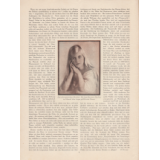
|
Article:
Parsen, P., The Art of Being Young and Beautiful. 2. The Well-Groomed Hair (by P. Parsen, unknown author).
Matching the article is a photographic image of Daisy, Baroness von Freyberg or Daisy d'Ora (1913-2010). The caption reads "A beauty that has become rare: the young Baronesse Freyberg in the adornment of her long golden blonde hair."
Photo: unknown/unsigned.
[Parsen, P., The Art of Being Young and Beautiful. 2. The Well-Groomed Hair].
[Continued from p. 3] If we looked back at the ladies of the Rococo with a quietly regretful smile, we have to admit — if we want to be objective — that the modern woman of 1927 is also an eager follower of hair fashion. Never before has the art of hair coloring been in such bloom as in our days! This is absolutely not an achievement of modern times: Thousands of years ago, the ladies of the Pharaohs already loved to give their hair a different color than the one given by Isis and Osiris, Rome's distinguished womankind inherited these secrets along with many others from the land of the pyramids, the ladies of the Renaissance, in addition to all kinds of love potions and sinister poisons, already knew the means to give their hair demonic red, as shown in Titian's wonderful paintings. The lady of today is only the last link in a chain of women who continue to play the old game "Corrigez la nature" with regard to hair color. The only difference is that here, too, modern science has succeeded in avoiding methods that are harmful to health. The dye of the modern hair artist is harmless: whether the Hennah was really already in use at the time of the Pharaohs, we do not know with certainty; but it seems almost certain, since it is still today in the Orient the most popular dye. It is certain, however, that its proper use is in no way detrimental to the hair, but on the contrary even has strengthening effects. The hot, soft mud pack of henna clay strengthens the hair shaft and has a stimulating effect on the head nerves and vessels of the scalp. Of course, it is a matter of taste whether a lady wants to beautify her hair by artificial coloring. That it can be aesthetically correct in the case of miscolored hair and in the transitional period to the snow of old age is not to be disputed. But whether it is really necessary to surprise the astonished fellow world in every season by a new "modern" hair color, seems nevertheless very questionable. The popular humor, which instinctively always hits the right thing, has coined for these overzealous servants of fashion the joking answer: "I remember them — dark," and thus pronounces judgment on such exaggerations. Whoever decides to have his hair dyed, should take a close look at himself and check in strict self-criticism which color really suits his whole being, actually embellishes it without attracting attention. Because everything loud, flamboyant is always unattractive.
It is equally unattractive when the woman forces her most beautiful ornament, the hair, into unnatural shapes. Again, we have no right to mockingly remember past generations! For even our hairstyles are subject to fashion, which may smile at our follies in a few decades. Many a hairstyle, which was and is considered the highest chic, is not only unattractive — because unnatural — but above all highly harmful to the hair. This includes all hairstyles that have to be produced artificially with the hot curling iron; for it is obvious that the continued work with the curling iron leads to the drying out and thus to the brittleness of the hair, and that the heat in the vicinity of the nerves of the head must damage them. Modern hairdressing therefore avoids the burnt marcel wave whenever possible and produces the same effect, but harmlessly, with the "water wave": the hair, damp after washing, is placed in the desired shapes with a moistened comb, pressed tightly against the head with a hairdressing cap or veil, and dried in this way. Such waves last as long and even longer than the burnt ones. The discovery of the water wave coincides with the introduction of the bob, that much disputed hairstyle of the lady of our time. Rarely has a fashionable controversy excited the minds as much as the battle under the slogan "Here long hair braid, there bob!" We don't want to be arbiters either: after all, this is a matter of personal taste, which each individual has to settle with herself and — her husband. Absolutely unattractive is neither the long hair nor the bob! The latter, however, has recently been heavily burdened by the attempt to transform the feminine possible costume of short hair (which, by the way, was also worn 3,000 years ago in the land of pyramids and sphinxes, as scholars have determined) into impossible masculine lines. The common sense of our women, however, just as with the masculine line in clothing fashion, has turned in on itself, and even with the bob, a decidedly feminine tendency now prevails. The smooth, hard lines have disappeared, and the curl, teasing and coquettish, triumphs. So all modern hairstyles feature soft lines, gentle waves, and fun curl arrangements at the back of the head, sometimes almost straining the profile backwards a little too much. After all, the effort to redirect the revolution of short hair into evolution and find a generally satisfactory compromise between long and short is clearly visible. And with this, the boyish bob would also secure its future: for that it is practical and in keeping with the style of the independent woman of the post-war period, even its opponents and detractors, if they are objective, will not doubt. After all, the still growing number of curls that fall victim to the scissors proves that the short-cut hair is not a fashion whim born today to disappear tomorrow. It can be said with some certainty that the bob is not a fashion, but a contemporary phenomenon, the expression of the will of our woman of today to adapt herself to the new times, even externally. For the decision of this "main section of the woman question" as a well-known pop composer once called the bob, in the personal case one will just always have to keep to old master Goethe's word: "See everyone, how he does it!" Whether short or long — the hair is a delicious gift, with which nature enriched the beauty of the woman; this imposes on her the duty to care for it to the best of her ability! P. Parsen.
[Page] 4
|
|
P. 5 |
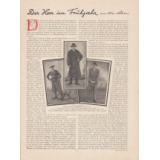
|
Article:
Alsen, Ola, The Gentleman in Spring (by Ola Alsen, 1880-1956).
Three photographs illustrate the article. The caption for the three images reads "Middle image: springtime ulster overcoat in English cloth with wide lapels and belt. Left image: Kurt Vespermann [German actor, 1886-1957, note by M. K.] in a brown and sand patterned sweater and knickerbockers. Right photo: Russian film actor Vladimir Gaidarov [1893-1978] in a gray jacket suit. Photos: Sandau."
Photos: Ernst Sandau, Berlin (1880-1918, studio later taken over by Suse Byk, 1884-1943).
[Page] 5
|
|
P. 6 |
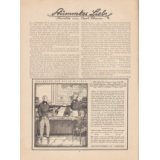
|
Article:
Rhan, Carl, Stuemmke's Love. Novella by Carl Rhan (1874-1955).
Advertising:
From time immemorial, respectable merchants have not only thought of their own advantage, but have also always protected the interests of their customers in their calculations. In the spirit of this good tradition, which our house has upheld at all times, we have set the price for a whole bottle of Pixavon at M 2.50. Experiments by experts have shown that one bottle of Pixavon can wash 10 "boys' heads" or 8 heads with long hair or 12 men's heads, i.e. on average ten hair washes can be performed with one bottle of Pixavon. So each Pixavon hair wash — if done at home — turns out to be only 25 pfennigs. Today, regular hair care with Pixavon is considered an indispensable prerequisite for a well-groomed appearance. Every week a hair wash with Pixavon gives the hair soft fullness, shimmering shine and easy styling. Look for the name "Pixavon" (only in original closed bottles). Pixavon is available at all druggists and hairdressers, sufficient for 10 washes whole bottle M 2.50, 5 washes half bottle M 1.50, 1-2 washes baby bottle M —.50. We have made it our principle to always supply the same high quality product, even if we ourselves have to be content with a lower profit. LINGNER-WERKE A.-G. / DRESDEN. Drawing by Erich M. Simon (1892-1978).
[Page] 6
|
|
P. 7 |
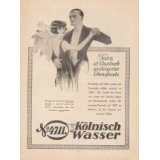
|
Advertising:
Full-page advertisement: Dance is an expression of increased joy of life.
Fatigue and heat mean nothing to the dancers, if "4711"refreshes them. The enjoyment of the party is enhanced by its lovely coolness and invigorating power. To serve the graceful partner with "4711" is the dancer's noblest duty.
Only genuine with the legally protected (blue and gold label). — Since 1792, always in the same, unsurpassed quality according to the time-tested original recipe. 4711 Eau de Cologne. Drawing/illustration: unknown/unsigned.
[Page] 7
|
|
P. 8 |
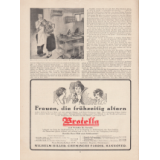
|
Article:
Rhan, Carl, Stuemmke's Love. Novella by Carl Rhan (1874-1955).
The illustration for the novella shows an elderly gentleman wearing a white apron and a woman standing close to him. Both are standing in a domestic workshop. The caption reads "Gently he stroked her hair with his calloused right hand."
Drawing/illustration: unknown/unsigned.
Advertising:
Women who age prematurely must place special emphasis on healthy gastrointestinal digestion, because premature wrinkles, pale or blemished complexion, and the many other "blemishes" are mostly caused by constipation, poisoning of the body and blood from the intestines.
Brotella according to Professor Dr. Gewecke means the end of constipation because, unlike laxatives, it strengthens the intestines, smoothes, mucilages and rejuvenates the intestinal walls, thus eliminating the cause of constipation.
Brotella intestinal diet instead of laxatives!
For general use:
1. Brotella-mild for gastrointestinal disorders, mild constipation and for children… Pfd. M. 1.40.
2. Brotella-strong, for chronic constipation… Pfd. M. 2.—.
For special use:
3. Brotella for corpulent, for constipation and obesity… Pfd. M. 3.50.
4. Brotella for diabetics, for constipation and diabetes… Pfd. M. 3.50.
5. Brotella for the nervous, for constipation and nervous disorders… Pfd. M. 3.50.
New Brotella cookbook 25 pf. In pharmacies, drugstores, health food stores.
WILHELM HILLER, CHEMICAL FACTORY, HANOVER.
Drawing/Illustration: "W J" (unknown signature).
[Page] 8
|













